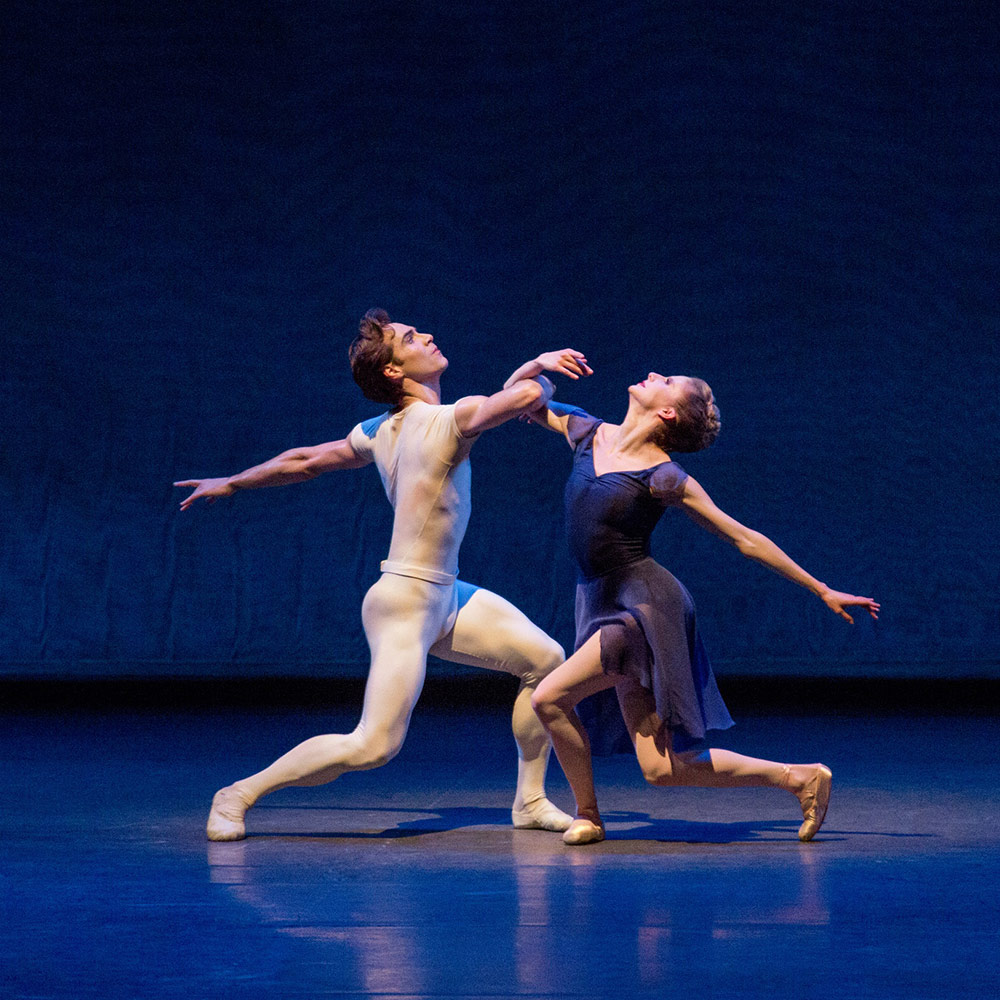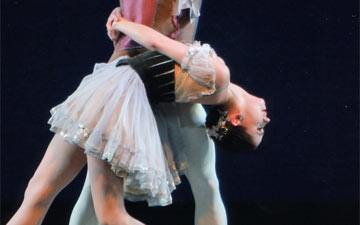
© Paul Kolnik. (Click image for larger version)
New York City Ballet
Balanchine, Robbins & Reisen: Composer’s Holiday, Kammermusik No. 2, Opus 19/The Dreamer, Symphony in C
★★★✰✰
Washington, Kennedy Center Opera House
2 April 2019
www.nycballet.com
www.kennedy-center.org
Before the curtain went up on New York City Ballet’s opening program at the Kennedy Center, the newly appointed artistic leaders of the company, Jonathan Stafford and Wendy Whelan, walked on stage to address the audience. “We are really proud to be standing here,” said Stafford, who is artistic director of the troupe. In his speech, he recalled his memories of dancing on the Opera House stage, noting that New York City Ballet has been performing at the Kennedy Center since 1974. Whelan, who holds the position of associate artistic director, briefly described the four ballets on the program.
It’s quite unusual for the artistic management of a ballet company of such caliber as NYCB to directly engage with the audience before the show. But the recent turbulent events that shook this troupe, including the resignation of its longtime director, Peter Martins, and a sexual harassment lawsuit filed by a former School of American Ballet student that led to the dismissal of three principal male dancers, made this opening remarks not only appropriate but also necessary. Standing before the audience to express their gratitude and pride for being on this stage, back in Washington DC, the new artistic team was sending a message that the company is in good and capable hands. No doubt the audience appreciated the gesture.
Gianna Reisen’s NYCB choreographic debut (in 2017), Composer’s Holiday, opened the program. Reisen was just 18 years old when she was commissioned by the company, thus becoming the youngest choreographer in NYCB’s history. Quirky and fast-paced, Composer’s Holiday has loads of charm and brims with youthful energy and invention, all propelled by the acerbic dynamics of Lukas Foss’s Three American Pieces for Violin and Piano. Here two leading couples (Mary Thomas MacKinnon, Kennard Henson, Emma Von Enck and Roman Mejia) are aptly juxtaposed with an ensemble of eight dancers (four men and four women) in chic black, beige and white costumes; and the choreographic intricacies and surprises of this juxtaposition proved the chief pleasure of this piece.

© Paul Kolnik. (Click image for larger version)
Yet at times this Holiday looked somewhat hectic. It felt as if Reisen wanted to use all her imaginative ideas at once. As a result, the ballet lacked organic flow and some of the choreographic passages, however sculpturally elaborate and theatrical, looked too cumbersome to deliver the desired visual and emotional impact.
After a short pause, there was another modern abstraction featuring two couples and an ensemble of eight dancers: Balanchine’s Kammermusik No. 2. Named after its music – Paul Hindemith’s 1924 concerto for piano and chamber orchestra – this piece presents Balanchine in his hard-modernist mode. The ballet’s movement vocabulary is jagged and twisted; the mood is stark, the music jarring. It’s not an easy piece for the eyes and the ears.
The cast, led by Teresa Reichlen, Abi Stafford, Joseph Gordon and Russell Janzen, made an admirable effort to keep up with the propulsive rhythms of Hindemith’s score and with the convoluted shapes of the choreography; but their dancing often seemed unfocused and out of sync. And the blazing energy this ballet demands simply wasn’t there.

© Paul Kolnik. (Click image for larger version)
Assembling a well-balanced program is an art in itself. “What comes before or after a ballet influences your reaction to it,” Jerome Robbins used to say. “Ballets are like dinner courses.” Alas, this program was oversaturated with abstract ballets set to astringent music. I doubt Robbins would have been happy to see his stark Opus 19/The Dreamer coming on the heels of Balanchine’s equally austere Kammermusik. But he would have definitely appreciated the excellent performance of this work delivered by the entire cast during this performance; the leads – Gonzalo Garcia and Sterling Hyltin – were particularly impressive.
Created in 1979 as a vehicle for Mikhail Baryshnikov and accompanied by the jarring strings of Prokofiev’s Violin Concerto No. 1 in D Major, Opus 19 feels at once nostalgic, mysterious and dreamy. Describing the central male role, Baryshnikov wrote: “He’s a bit of an outsider, a bit of a loner, a bit of a thinking man; there is a bit of action, a bit of unrealized romance, which is very much Jerry’s life.” And this is pretty much how Garcia portrayed his hero, projecting in his dancing an air of enigma, detachment and heartbreak. The willowy and supple Hyltin, in the role originated by Patricia McBride, was equally enigmatic and serene, rendering her part with appealing plasticity and nuance.

© Paul Kolnik. (Click image for larger version)
Balanchine’s Symphony in C, with its cheerful melodies and beautiful architectural designs, ended the evening on a triumphant note. In the opening movement, Ashley Bouder and Tyler Angle brilliantly caught the invigorating spirit and virtuosity of the choreography. In the elegiac Adagio, Sara Mearns brought her unique dramatic fervor to the leading ballerina part, imbuing her performance with grandeur and a touch of glamour; and the corps de ballet dancer, Baily Jones, made an impressive turn in the third movement, dancing with solid technique and radiance. Delivered with an extra jolt of energy and vigor, the ballet’s rousing finale turned into a dazzling celebration of music and dance.

















You must be logged in to post a comment.